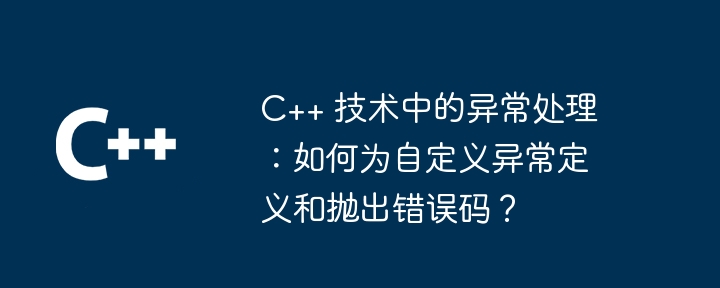
C In exception handling, custom exceptions and error codes can provide more detailed error information. You can define an exception class derived from std::exception, including descriptive member variables and functions, and use the std::make_error_code() function to throw an exception containing an error code. After an exception is caught, the error message can be accessed from e.what() and the error code from e.code() for more efficient error handling and diagnosis.

In C, exception handling is a powerful mechanism that allows us to be elegant Handle error conditions gracefully, thereby improving code readability and maintainability. Defining and throwing custom exceptions, together with error codes, can provide more specific and useful error information, thereby helping us quickly diagnose and solve problems.
In order to define custom exceptions, we need to create an exception class derived from std::exception. This class should contain member variables and functions that describe the error.
For example, we can define an exception class named MyException:
#include <stdexcept>
#include <string>
class MyException : public std::exception {
private:
std::string message_;
public:
MyException(const std::string& message) : message_(message) {}
const char* what() const noexcept override { return message_.c_str(); }
};When an exception is thrown, we also An error code can be included to provide additional information about the error. We can use the std::make_error_code() function to create an error code.
The following is an example of adding an error code to a MyException exception:
#include <system_error> throw MyException(std::make_error_code(std::errc::invalid_argument).message());
Consider the following code example:
try {
// 可能会引发错误的代码
...
} catch (const MyException& e) {
// 处理错误,并从 e.what() 访问错误消息
std::cerr << "Error: " << e.what() << std::endl;
// 还可以从 e.code() 访问错误码
std::cerr << "Error code: " << e.code().value() << std::endl;
}std::errc::invalid_argument. Instead, define your own error codes to provide more specific error information. The above is the detailed content of Exception handling in C++ technology: How to define and throw error codes for custom exceptions?. For more information, please follow other related articles on the PHP Chinese website!
 What are the differences between c++ and c language
What are the differences between c++ and c language
 Recommended learning order for c++ and python
Recommended learning order for c++ and python
 Cost-effectiveness analysis of learning python and c++
Cost-effectiveness analysis of learning python and c++
 Is c language the same as c++?
Is c language the same as c++?
 Which is better to learn first, c language or c++?
Which is better to learn first, c language or c++?
 The difference and connection between c language and c++
The difference and connection between c language and c++
 C++ software Chinese change tutorial
C++ software Chinese change tutorial
 Cost-effectiveness analysis of learning python, java and c++
Cost-effectiveness analysis of learning python, java and c++




